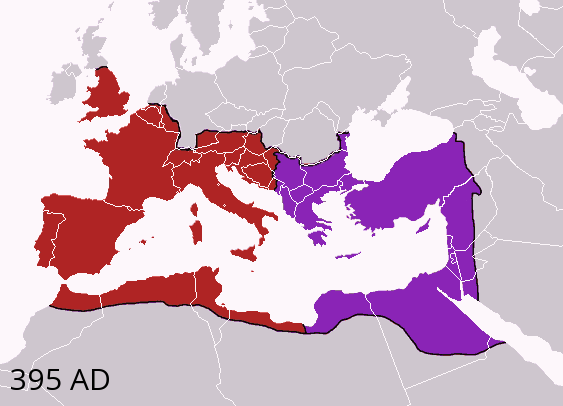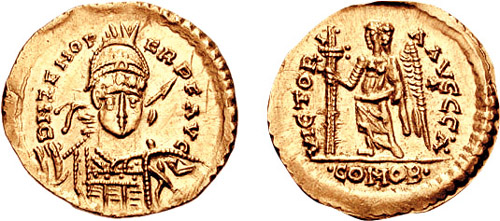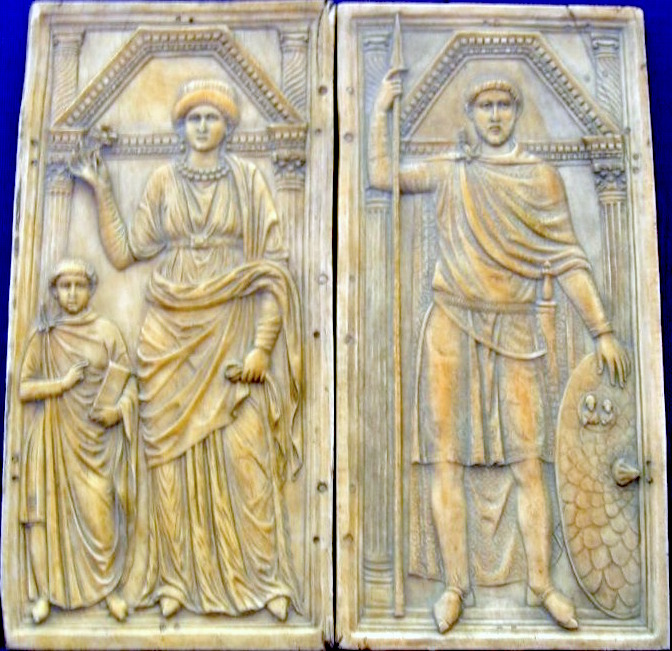'The Roman Empire fell in 476', or something similar, is a phrase which often finds its way into popular history books, but there are many different interpretations as to what this means. Indeed, in order to fully understand what actually 'fell' in 476, we need to ask both what didn't fall then and what had already fallen before this date.
 |
| The Western and Eastern Roman Empires after c.AD 395 (source: Wikimedia Commons). |
First and foremost, it does need to be remembered that a general belief that the Roman Empire fell in 476 can only ever work if one is willing to forget that the empire had been intermittently split into two halves ever since the later third century and that the eastern half—based at Constantinople—continued in existence for nearly another 1000 years up to its final destruction in 1453. Although this 'Eastern Roman Empire' is known to most modern scholarship as the 'Byzantine Empire', this name was first coined in the mid-sixteenth century: in the medieval period it was usually known as the Imperium Romanorum, 'the Empire of the Romans', or Rhomania, 'the land of the Romans'. Indeed, in the Middle Ages the 'Byzantines' were usually considered by both themselves and outsiders to be quite simply Rhomaioi, 'Romans', living in Rhomania under an emperor whose official title was the Basileus ton Rhomaion, 'Emperor of the Romans'. In consequence, any claim that the Roman Empire as a whole ended in 476 is completely without foundation in face of the continuing imperial presence in Constantinople.
 |
| An animated gif of the varying extent of the 'Byzantine Empire', AD 476–1400 (source: Wikimedia Commons). |
Given that a general notion that the Roman Empire ended in 476 cannot be sustained, what of a more specific one referring only to the end of Western Roman Empire? Can it be said that 476 was a key date in the end of a 'Romanised' western Europe and the fall of the Western Empire? Certainly with regards to the former point, the answer is probably no, 476 signified little in terms of the Roman 'character' of western Europe. Italy provides an obvious case study in this context, particularly during the time of Theoderic (AD 493–526). Here, in the ancient core of the Western Roman Empire, there remained strong ties to the Roman past through the later fifth and sixth centuries. Although political power had passed to the Ostrogoths, the administrative and taxation systems continued to be run by Romans in the Roman manner, and Roman judicial arrangements continued for the non-Gothic element of the population. Indeed, Theoderic appears to have adopted a deliberately Roman style of rule, with the resumption of the supply of corn to the masses and programs of reconstruction and rebuilding of public works such as bath-houses. In other words, the Italian state remained essentially Roman in structure and character, with the native population retaining its Roman culture; moreover, the 'barbarian' Goths actually became Romanised themselves over time, adopting Roman customs, language and religion.
| The mausoleum of Theoderic at Ravenna in the nineteenth century (Photo by Fratelli Alinari, c.1865–95) |
So, the Roman Empire certainly didn't cease to exist in 476, Roman-style governance and culture didn't suddenly disappear, and even the territory of the Western Roman Empire continued to be—theoretically—under imperial jurisdiction. Nonetheless, 476 still has a modicum of legitimacy as a notional end-point, at least for the Western Roman Empire as distinct political unit, as after this date even Italy was no longer under its control. However, even here there are questions, not least whether the Western Roman Empire still existed in any meaningful form up until 476, or if it was just as ephemeral before Odovacer's conquest of Italy as the post-476 claims of imperial authority over the West were.
 |
| A solidus of Odovacer struck in the name of the Emperor Zeno, testifying to the formal submission of Odovacer to Zeno (source: Wikimedia Commons) |
There are really two questions that must be answered in relation to the pre-476 Western Roman Empire. The first of these is, quite simply, how significant was the Western Empire in the years before 476? In the fourth century there seems to be very little evidence for any change in the nature of Roman power, rule or security; the army was still strong and the much-discussed 'barbarian' invasions posed very little problem for them except in times of civil-war. So, for example, the civil wars of 350–53 led to the abandonment of all the frontier forts north of Mainz with result that the Franks and the Alamanni invaded; nonetheless, the continuing strength of the Roman army was such that, once the internal difficulties were resolved, these 'barbarian' invasions were successfully dealt with. Indeed, for the most part the 'barbarian' incursions took the form of small-scale raids rather than invasions, and in 367 and 369 the Empire was able to lead armies in an offensive against the Goths.
By the fifth century, however, this situation had changed dramatically. The first indications of a change comes with the entry of the Visigoths into Roman territory in the late 370s, which seems to have taken the form of a full-scale tribal migration and attempt at settlement, rather than a transient raid. In the early fifth century such a situation becomes almost commonplace, with the Roman Empire seeing massive incursions into its territory by invading and migrating groups of 'barbarians', which far surpassed anything that the army had had to deal with previously. As to why this sudden change in the nature of the 'barbarian menace' occurred, Peter Heather has argued persuasively that the answer lies with the Huns. The Roman army seems to have been able to deal effectively with the 'barbarians' previously because they were usually raiders rather than settlers who were not united, attacking piecemeal. As such they presented the Empire with a manageable problem. The threat of the Huns seems, however, to have 'united' the 'barbarians' in a common cause—to get away from the Huns by moving permanently within the borders of the Roman Empire—and this meant that the advantage that the imperial army had previously enjoyed had ceased to exist.
| Attila the Hun meeting Pope Leo, from a fourteenth-century miniature (source: Wikimedia Commons) |
The result of this was that the Roman army was overwhelmed and alternative solutions other than the simple application of force had to be used in order to 'solve' these problems. Now the usual policy became one of calming the situation whilst, at the same, time saving face until arrangements could be made to deal with the 'barbarians' from a stronger position. So, in 418 a settlement was reached with the Visigoths that delegated political control of southern Gaul to them as 'political appointees' and then, over the next few decades, the Empire attempted to wrest this delegated control back. This would seem to be a sensible—and the only really viable—policy given the situation, but it suffered from a continuity in Roman obsessions. In the fourth century, the Roman generals and rulers had usually preferred to deal with internal problems and struggles first before dealing with any 'barbarian' troubles, with (for example) the Frankish and Alamannic invasions left unchecked until internal hostilities had been resolved. Unfortunately, this ordering of priorities was retained despite the changed tactical situation. The result of this was that, whilst the Roman generals conducted their internal power struggles, the 'barbarians' secured their hold on the territories they had taken control of, including the economically vital province of Africa, which passed into the hands of the Vandals in the 430s. As a direct consequence of this situation, the Empire suffered a major decline in revenues, which meant that it was increasingly unable to support its army and was, therefore, increasingly incapable of retaking its 'delegated' territories as it intended to—indeed, by the 450s there seems to have been no military force available to even protect Italy from the invading Huns.
The above description makes the nature of pre-476 rule appear to be much like that after 476, particularly from the 440s onwards when the aftershock of the loss of Africa starts really to be felt. This is not, of course, entirely true, as Rome and its empire still seem to have been important in and of itself to the 'barbarians' in this period, whilst after 476 it could be argued that the 'barbarians' found it merely convenient to subscribe to the myth of continuing Roman rule in the West as a way of legitimising their own rule. What we see is perhaps better characterised as a gradual decline throughout the fifth century from direct imperial control to increasing 'delegation' and eventual insignificance. Up to the 450s Rome still seems to have been respected and the focus of provincial loyalties, but its impotence in the face of the Huns led to attitudes slowly changing. After Aëtius's death, the Visigoths felt bold enough to sponsor their own Emperor (Avitus) and there is evidence of increasing numbers of Gallo-Romans switching allegiance away from Rome towards the Visigoths, who were obviously seen as being politically more significant than the Western Roman Empire in mid-fifth-century Gaul. By the 470s, it was deemed more advantageous for Ricimer's nephew and successor to compete for the control of the 'barbarian' Burgundian kingdom than to stay and support the puppet emperor Glycerius that he himself had set up, and in 475 Euric the Visigoth ignores the remnants of the Empire in favour of conquering Spain and Gaul. The polity that 'fell' in 476 thus cannot really be said to be any more than a pale shadow of what the Western Roman Empire had been. It was no longer a military power and it was of little importance beyond the use of its titles in legitimizing 'barbarian' rule—the Western Roman Empire's rule had become an anachronism and can probably be said to have been over for some time before Odovacer took control of Italy.
| A coin of Glycerius, Western Roman Emperor from 473–4 (source: Wikimedia Commons) |
Secondly, we must ask what was the nature of the Western Roman Empire itself? This is partly answered by the above—it was an anachronism that seems to have been, in reality, dead for sometime—but we ought also to recall that part of the fundamental character of the Roman Empire was that it was ruled by an emperor who controlled the military forces and therefore the means of power. Indeed, many Roman emperors, including Constantine the Great, gained their position by rebelling against an existing emperor with the backing of a large number of troops, who then elevated them to the imperial throne. In the Western Roman Empire, however, there seems to have been an alteration to this basic definition of power within the state from the late fourth century onwards, with power devolving to the generals without the need for them to become emperor.
This process started with the reform of the army by Diocletian, who gave the command of frontier armies increasingly to professional soldiers instead of civilian provincial governors. This reform was then carried further by Constantine and his successors, who created a new, mobile army that wasn't linked to the frontiers and the high command of which was reorganised, with the civilian Praetorian Prefect's military authority being transferred to a Master of Cavalry (Magister equitum) and a Master of Infantry (Magister peditum). This did produce a more efficient army, but it also gave far more power to the generals too. In the Eastern Roman Empire this was less of a problem, as it was the seat of the 'senior' Emperor, who kept direct control of his forces. The Western Empire, however, was a different matter, as it was the seat of the 'junior' Emperor who was usually young, weak or weakened so as to prevent challenges to the Eastern Emperor's authority. Hence, for example, Valentinian II acted as a puppet for Emperor Theodosius, who separated the imperial person in the West from his military forces by giving control of the field army to General Arbogast. Needless to say, this was a very significant event. From this point, the Western Empire saw a series of 'military dictators' who held the real power, most notably Stilicho in the late fourth and early fifth centuries and Aëtius and Ricimer in the early to mid-fifth century. Indeed, the fact that these generals saw their position as preferable to that of the actual Western Emperor becomes increasingly obvious over this period. Arbogast, after the death of Valentinian II, raised Eugenius to the imperial rank in the West rather than himself; Stilicho was happy to remain as commander of the field armies rather than to depose the young Emperor Honorius; and from the 450s puppet emperors, set up by the generals, become very common indeed. In other words, in the Western Empire, men who would have in previous generations sought to make themselves emperor were now more often than not satisfied to remain generals in control of the military, rather than become the head of state.
 |
| A copy of an ivory diptych of Stilicho, right, and his family, carved c. AD 395 (source: Wikimedia Commons) |
The inference to be taken from the above is, of course, that the rank of Roman emperor was no longer desirable in the West for most potential candidates, and that it was increasingly associated with weakness and puppet government. Power in the Western Empire rested rather with the man who controlled the armed forces, the Master of the Soldiers. Indeed, by the time we reach the 470s it becomes clear that these 'military dictators' no longer even feel a debt of loyalty to their puppet head of states. Gundobad, for example, was a Master of the Soldiers who installed the Emperor Glycerius on the throne, but in 473 he abandoned the Western Empire in order to compete for the control of the Burgundian kingdom. Not only was the de facto ruler of the Western Empire not the emperor, but the 'Master of the Soldiers' was only interested in his own power by this point—when the Western Empire became effectively irrelevant in contemporary politics, it was simply abandoned in favour of more advantageous posts.
The content of this post and page, including any original illustrations, is Copyright © Caitlin R. Green, 2014, All Rights Reserved, and should not be used without permission.
